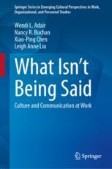Search
Search Results
-
I vs. robot: Sociodigital self-comparisons in hybrid teams from a theoretical, empirical, and practical perspective
This article in the journal Gruppe. Interaktion. Organisation. (GIO) introduces sociodigital self-comparisons (SDSC) as individual evaluations of own...

-
The saving enhanced memory effect can be observed when only a subset of items are saved
Saving one list of words, such as on a computer or by writing them down, can improve a person’s ability to learn and remember a second list of words...

-
A Pilot Study of Observing Responses in Dyadic Competition
Competition is said to be arranged when reinforcers are distributed unequally based on the participants’ performances. Responses that produce access...

-
Preserving Teacher and Student Agency: Insights from a Literature Review
This chapter is a comprehensive literature review that explores the influence of artificial intelligence (AI) on education and its implications for...
-
Human–Technology Interfaces: Did ‘I’ do it? Agency, Control, and why it matters
Our interactions with the environment are often accompanied by instances of experience where we feel in control of our actions. This agentive...
-
Understanding the Progression from Early Alcohol Use Experimentation to Alcohol Use Disorder: Testing Vulnerability by Experience Interactions Using a Two-Part Latent Growth Curve Model
Most adolescents experiment with alcohol, but a smaller percentage advance to heavy alcohol use (AU) and AU disorder (AUD). Understanding for whom...

-
RELATIONAL DIMENSION VERSUS ARTIFICIAL INTELLIGENCE
Thirty years ago, we proposed the similarity between the functioning of artificial intelligence and the human psyche, suggesting multiple parallels...
-
Conclusion: Intelligence Does Not Inhere Within the Individual but Rather in Person x Task x Situation Interactions
Historically, intelligence has been viewed as a trait—a characteristic of a person that is at least partially heritable and that is relatively...
-
A virtual reality platform for memory evaluation: Assessing effects of spatial strategies
Human spatial memories are usually evaluated using computer screens instead of real arenas or landscapes where subjects could move voluntarily and...

-
Temporal binding is enhanced in social contexts
Temporal binding (TB) refers to an underestimation of time intervals between two events, most commonly for actions and their effects. This temporal...

-
Technology-Based Methods for Training Counseling Skills in Behavioral Health: a Sco** Review
In the present review, we consider technology-based methods for training and monitoring counseling skills in behavioral health (i.e., addictions,...
-
Digital
This entry explores the influence of digitalization on human creativity, focusing on the basic strands of creativity originally identified in Mel...
-
What’s Not Being Said When Communications are Virtual?
The use of virtual interactions, characterized by geographic dispersion, electronic dependence, dynamic structural arrangements, and national...
-
Should Technology Be More Fun(ny)? Leveraging Humor to Improve User Acceptance and Enjoyment of Social Robots and Virtual Agents
Humor plays a pivotal role in social interactions and is linked to various health benefits. Therefore, there is a vast potential for harnessing its...
-
Psychological Factors Impacting Adoption of Decision Support Tools
The general increase in the speed of automation has made humans in the loop a process constraint. Integrated decision support tools can help close...
-
Evolutionary Behavioral Sciences
This chapter covers evolutionary behavioral sciences in general, both animal and human disciplines. Firstly I briefly sketch the historical...
-
Predictive processing of scenes and objects
Real-world visual input consists of rich scenes that are meaningfully composed of multiple objects that interact in complex but predictable ways....

-
State of Development and Research
So, what might an initial thought framework of digital psychology look like? Systemic adaptations, the complexity of digital spaces, research on...
-
Eye Movements and Human-Computer Interaction
Gaze provides an attractive input channel for human-computer interaction because of its capability to convey the focus of interest. Gaze input allows...
-
Semiosis in Artificial Intelligence-Mediated Environments: Exploring the Signs of Social Media Burnout
This chapter focuses on digitally mediated communication, particularly within Social media platforms using Artificial Intelligence recommendation...
